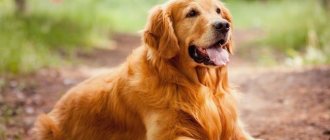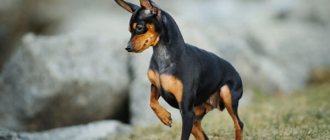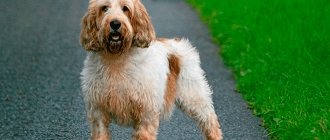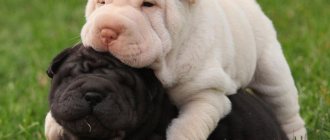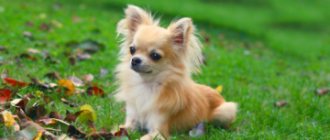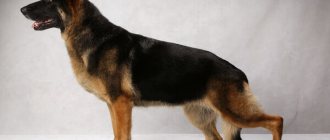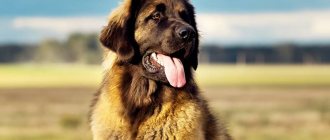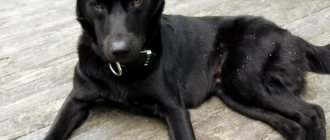The Basset Hound is an amazing dog with a clumsy gait and sad eyes. Thanks to her easy-going character and memorable appearance, she is popular all over the world. The breed was bred for hunting and is classified as a hound. But now Basset Hounds live in the house, they are wonderful companions and caring nannies. These dogs are smart, friendly, unpretentious. And thanks to their medium size, they are ideal for keeping in a city apartment or private house. The breed has many fans all over the world. But before you get a Basset Hound puppy for the first time, you need to understand the features, learn about the pros and cons of these dogs, and study the prices.
- Head
- Upbringing
- Care
Description of the Basset Hound breed
Popularity 162nd among 263 dog breeds
Lifespan:
10-12 years
Breed group:
Hounds
Height:
33-38 cm
Country of origin:
France, UK
Average price:
25-35 thousand rubles
Weight:
18-29 kg
Latest articles Cat health
Rabies vaccination for cats: choice of vaccine, necessity, schedule 01/22/2022 4 0 0
Selection and adaptation
TOP 20 best cat breeds for families with children 01/22/2022 25 0 0
Key facts
According to the characteristics of the breed, the Basset Hound is a hound, has very short legs, good adaptability to terrain, and has an excellent sense of smell. The folds above the eyes give the impression of a perpetually sad mood, but the breed is very cheerful and has great intelligence and loyalty. The male and female are of a fairly muscular build; the size of the Basset Hound is without strong gender differences: the difference in weight rarely reaches 2 kg.
Excellent hunters, devoted companions for their owner, basset dogs require a lot of attention. As a reward, the owner will receive loyalty and the opportunity to watch a real English gentleman every day. Short legs and a good sense of smell made them excellent burrow hunters.
In their homeland, basset dogs are called “couch athletes” due to their powerful, muscular body and desire to lounge on furniture. Periods of activity are replaced by a desire to be a little lazy. Remember: the hunting instinct is not forgotten even in indoor dogs; on the street it will be difficult to distract a dog that is “on the trail.”
The Basset needs a lot of walking, just like any hound. Don't be fooled by its homely appearance - you'll have to spend a lot of time outdoors.
The Basset Hound has a deep and bright voice, and your neighbors will witness this when the dog is left at home alone. Take care not to leave your dog alone for long periods of time.
The description of the Basset Hound breed includes one distinctive feature: extremely high intelligence, and some experts call the Basset Hound one of the smartest dogs.
A long body, a good sense of smell, short legs - all this made the dogs excellent burrow hunters. With them you can go after a hare, fox, badger.
The health and lifespan of a Basset Hound depends on its care. If a dog is not sick with anything, it can live 12 years or more.
Hound colors and coat type
Basset hounds differ from other four-legged animals not only in their body structure, but also in their coat. It is usually short, close to the body. You can find representatives with hard hair and soft guard hair. Before buying a dog, study its colors. Occurs:
- Red - Breton (very popular today). The color of the dogs corresponds to the description: there are shades of red and fawn. Sometimes there are black hairs on the back, near the ears. White markings occur on the chest.
- Norman. The variety is distinguished by its red color with white and black spots.
- Blue - Gascony. Blue color with black spots. There may be red markings above the eyes, near the ears, and on the paws.
- Vendéan - griffon. The main shade is white. There are black spots and brown color.
These types of dogs differ only in color. In nature, there are completely red dogs with white or yellowish paws. If you see a gray Basset Hound, the seller may describe this color as very rare. Know that sometimes such a feature is a sign of a genetic disorder, so it is best to refuse the purchase.
History of the origin of the Basset Hound
The basset definitely looks like a British dog; the official homeland in all sources is Great Britain, but in fact the country of origin of the basset hound is France. It was there that the breed was first bred. The history of basset dogs begins in the Middle Ages and has quite interesting facts.
Books, manuscripts, and various illustrations from the Middle Ages in France convey notes about short-legged dogs from the Artesian-Norman hounds. In the 17th century, basset dogs were bred en masse in France.
The breed has received a new qualification. Now they went with them to hunt pheasants, and not just burrow animals. Of course, this was a hunt on foot; it was difficult for a basset to keep up with a horse. But the short legs served their purpose. Where a horse or a large hound could not go, the basset always got through. Shrubs, dead wood, and small ravines were within the capabilities of these hobbits from the world of dogs.
While the nobles were hunting, the commoners were not sitting idle. French peasants fell in love with Basset hounds for their excellent sense of smell and used them in search of truffles.
The breed received further development in Great Britain in the 19th century. Bassets were bred with Bloodhounds, and a local flavor was added in the form of very long ears and an elongated body. The real name Basset Hound appeared (“basset” means “low”).
In Russia, the breed began to develop only in the 70s of the 20th century, although it was originally imported under Peter I. The dogs were bought for a fabulous price, kept in the Izmailovo menagerie, but after the death of the reformer they were forgotten about.
Varieties of the basset hound breed, external differences
There are several varieties of the Basset Hound dog. External characteristics largely determine the desirability of the purchase if the dog does not need to hunt in the future. To select a puppy for exhibitions and competitions, it is recommended to seek help from an experienced dog breeder or breeder. This will help avoid marriage.
Interesting information! Translated from French, "bass" means "short". Previously, all short-legged hounds were called basset hounds, and then this name migrated exclusively to this breed.
Artesian-Norman Basset
Representatives of this species are short-legged dogs with an elongated body and a massive head. The dog has a convex skull with a clear transition from the forehead to the muzzle. Oval dark eyes look outwardly sad when calm. Thin ears with pointed ends are set low and curl into a spiral. The tail is long, thick, saber-shaped, and does not bend over the back. Colors: white, orange-white, orange-brown.
Artesian-Normandy Basset on a leash
Breton Basset Hound
Its height is ideally 36 cm. The pet has a golden-wheaten color with a more or less pronounced red sheen; there may be white spots on the chest. A short dog with short legs and an elongated body. Coat type: wiry.
Breton Basset Hound
Gascony Basset Hound
It is a short-legged hound with a large head and low-set, drooping ears. At the withers it can reach 42 cm, weighing up to 18 kg. The Basset is blue with black spots; there may be red spots on the face, paws and inside the ears. This dog is a smaller version of the giant blue hounds that it resembles in description.
Blue Gascony Basset with puppies
French Basset Hound
The French Basset Hound dog has a standard appearance for a Basset Hound: short crooked legs, a long body, an elongated muzzle with floppy ears. However, this variety is distinguished by its coarse, thick coat. The weight of the animal does not exceed 20 kg, the height of the dog can reach 40 cm.
Signs of a breed defect
According to the standard, the following are considered disqualifying defects:
- cryptorchidism;
- light yellow eyes;
- curvature in the joints of the limbs;
- pink or spotted nose.
Other defects in a Basket dog include long legs, tightly stretched skin, chicken breasts, a drooping or lean belly, and a rolled rut.
Pros and cons of the breed
The Basset is a dog of a specific breed, which is worth considering when purchasing it. It has both pros and cons. The advantages of an animal of this breed include:
- good-natured character, so the basset is an excellent option as a friend;
- well-developed hunting instincts, therefore, with careful training, the dog will be able to smell prey at a distance of several kilometers and follow the scent;
- good attitude towards children;
- ability to detect odors over long distances.
There are also many disadvantages:
- a number of genetic diseases associated with the spine and joints;
- tendency to obesity;
- sociability, due to which these dogs do not want to remain alone for a long time, they begin to misbehave and howl.
Note! The main disadvantage of the breed can be considered the need for careful care. The skin folds quickly become greasy, causing your pet to smell unpleasant. The dog needs to be wiped with a damp cloth every couple of days to avoid unpleasant odors. They also often splatter, making it necessary to constantly clean up after them.
Appearance of a basset hound
General impression
At first glance at a photo of a basset hound, it seems that what you are looking at is rather a lazy, clumsy caterpillar. Short-legged, with long ears, an eternal mournful expression on the face. Many funny pictures of this breed have circulated online. But…
The dog can experience any emotions, anger, joy, fun, fear, but the expression in the eyes will always show severe sorrow. When running, his long ears flutter so much that it seems as if the dog is taking off. It’s hard to imagine him as a hunter, but the short legs help with this – with them the dog becomes well adapted to the uneven terrain.
Head
Large, elongated, clearly protruding back of the head, parallel lines of the muzzle and skull, cheekbones and cheeks do not protrude, overhanging skin forms wrinkles around the eyes and eyebrows.
Neck
Muscular, long, elongated, well defined dewlap.
Torso
A wide back, withers and croup are located on the same line, the body is strong, muscular, elongated in size, harmoniously developed chest.
Forelegs
Short, strong, strong bones, tightly tucked elbows, slight S-curve allowed.
Hind limbs
Strong, powerful, parallel to each other, rounded hips, low hocks.
Tail
Long, strong, with a slight bend, raised upward when moving.
Movement
Rhythmic, free, not fast, hind and forelimbs are coordinated.
Wool
Short, no fringes.
Color
Usually found in two or three colors. All Basset Hound colors are acceptable for non-breeding purposes.
Size
Dogs have a heavy, elongated body. Basset Hound weight: 18-29 kg. Basset Hound height (height at withers): 33-38 cm. Too much height is grounds for disqualification.
Hunting qualities
Unfortunately, these dogs in our region are used extremely rarely for hunting, but in vain. But the basset hound breed is in unprecedented demand in the USA and Europe. Basset hounds are very passionate about hunting, so when they notice a foreign animal, they will immediately begin pursuit. The chase will be accompanied by a very loud bark, which is characteristic exclusively of this breed.
When chasing, the dog will forget about everything and can go a long distance. That is why it is very important to teach the dog basic commands, at the top of the list, which should be the call to return to the owner. It would be a good idea to teach commands using an ultrasonic whistle. This will help the four-legged hunter hear the call of the owner, while being at a very impressive distance.
They pick up a trail very well, especially a bloody one. They run slowly, but are more resilient than, for example, beagles. They take their prey by persecution and starvation. They can chase pheasants, a squirrel or a hare for hours, but will eventually lead it straight to its owner. The subtle scent of this breed does not give the prey a single chance to lose track.
It is recommended to take a group hunt for hog or other large game. They work great together with spaniels. If he sees a dachshund trying to get a fox out of a hole, he will try to do the same. Moreover, the character of basset hounds is absolutely fearless. It is recommended to take it both for open hunting and for field hunting when chasing prey.
Basset Hound Personality
Basset is a real aristocrat from Great Britain, a gentleman with a sad face. All this is appearance, but what is different about the personality of a basset hound?
This hunter is very friendly, active, and sociable. The dog is sociable and does not like loneliness. It feels bad at home without its owners, keep this in mind. Great sadness, sadness on the face is just a mask. The breed is cheerful and happy to make contact. Very smart, but moderately willful. Easy to train, provided the correct approach is taken to this gentleman of blue blood.
Children and other animals fit perfectly into the Basset Hound's life. He can even get along with cats. He lives well in an apartment, but at the same time he walks outside with great pleasure. Natural instincts are not forgotten, so be careful on the street. Once a basset gets caught up in someone's scent, it will be difficult to stop him.
The ideal option for an English hunter would be to live in a country house, where this short-legged dog can get plenty of exercise. Reviews from owners describe that even in winter, basset dogs feel good outside without overalls. All thanks to great activity and high-quality undercoat.
If you get a basset hound, give the dog plenty of attention. At home, he wants contact with the owner, otherwise all the neighbors will hear how loud your dog barks and howls. He does not accept privacy.
The difficulty lies in his stubbornness: when he wants to do something, he will do it, and it will be difficult to convince him. For example, the basset loves to lie on something soft, so rest assured: while you are at work, he will definitely sleep on your bed. A love of sofas and beds is a distinctive feature of the breed.
A basset puppy will charm you with its appearance and long ears, it will be affectionate and active, but an adult dog will be distinguished only by some waywardness. Who is the Basset Hound suitable for? An active person who lives in one place and also has the patience to communicate with a funny stubborn person.
Breed traits
Breed traits (on a 5-point scale)
| Basset Hound | |||
| Activity | in the house | 2.3 | |
| on the street | 3.3 | ||
| Obedience | training | 2.3 | |
| strangers | 2.9 | ||
| Domination | in family | 2.1 | |
| over dogs | 2 | ||
| Defending your territory | from people | 2.1 | |
| from dogs | 2.3 | ||
| Sociability | in family | 4.5 | |
| with strangers | 3.9 | ||
| with dogs | 3.6 | ||
| Concentration | in family | 1.9 | |
| in front of strangers | 2.3 | ||
| with dogs | 2.8 | ||
| Aggressiveness | in family | 1.4 | |
| to strangers | 1.7 | ||
| to the dogs | 1.8 | ||
| to cats | 1.8 | ||
| Family behavior | calmness | 2.8 | |
| demand for affection | 4.2 | ||
| excitability | 3 | ||
| playfulness | 3.8 | ||
| excessive barking | 3.2 | ||
| behavioral breakdowns | 2.2 | ||
| Tolerance for children | up to 4 years | 3.8 | |
| over 4 years old | 4.2 | ||
| Institutional use | watchman | 3.8 | |
| bodyguard | 1.8 | ||
This breed is often compared to the following dog breeds: Beagle, Bloodhound, Dachshund, Pembroke Welsh Corgi, Labrador Retriever.
Education and training
The question all owners ask. How to raise a dog so that it grows up to be an easy-going four-legged friend? The Basset Hound is an interesting, sociable breed, but at the same time it knows how to stand its ground and protect its interests. Take this feature into account when you begin raising and training your Basset Hound.
Command training should be carried out by a specialist or experienced dog breeder. You don't need to put a lot of pressure on the basset, you just need to find the right approach. Observe your pet, try to understand it.
Yes, he can carry out commands less clearly than a guard dog, constant comments will periodically irritate him. But if the training is organized correctly, the basset can greatly succeed in training.
Successful training cannot happen without a good incentive. Food is an excellent “engine of progress” for the basset hound. Just be careful not to overfeed this smart beggar. Otherwise, he will be very trained and at the same time incredibly fat.
Each exercise and lesson should not exceed 10 minutes, otherwise the dog will get tired. Accustom your basset not only to commands: he must get used to being alone for a while. Leave him alone for an hour at first, then increase the interval.
How to wean a puppy and an adult dog from collecting different things? Yes, he loves it, collecting slippers and various objects in a pile. There is no definitively successful solution to recommend. Keep valuables away as far as possible. If you notice that your pet chews furniture, shoes, or spoils things, try to buy new dog toys that he can chew without restrictions.
How to train a basset hound to go to the toilet regularly? The usual standard method will do: take the puppy outside after feeding. If he came from the street without results, go again after 5 minutes. Basset must understand that the job must be done.
If the floor is covered in puddles despite all your efforts, consider whether there is a place for injustice. The breed is touchy and knows how to do dirty tricks out of spite.
Is it possible to punish a basset hound? No, he shouldn’t, he will only hide in thoughts, then try to take revenge. Be an older friend and teacher; the dog will not want to tolerate a serious supervisor.
What time of year can you train a basset hound outside? In any case, in summer and spring it’s comfortable in any case. In winter, the Basset is not afraid of cold weather due to its thick undercoat. In the fall, especially in the rain, wear overalls. The dog loves to roll in the mud.
Pros and cons of the breed
If we summarize all that has been said, we can outline the advantages and disadvantages of this breed. The easiest way is to present them in table form:
| pros | Minuses |
| With proper training, Basset Hounds make good pets and loyal friends. | Representatives of the breed are stubborn and willful. They want their opinions to be taken into account |
| Tolerant of other pets | Do not tolerate loneliness well |
| Friendly, including towards children and strangers who come to visit | Basset hounds are no defenders of the master's property. The maximum that these dogs can do when they see a robber is bark |
| Cheerful and active | Often barks low and loudly, which disturbs neighbors |
| They have an aristocratic appearance. They behave ideally at exhibitions | Even with proper grooming, your dog will still have hair everywhere. |
| Not picky about food | The tendency to eat everything that is edible often leads to obesity |
| Excellent hunting helpers. Even without prior training, the Basset Hound will hunt down small prey. | They require regular hygiene procedures. Otherwise they start to “smell” |
| Representatives of the breed adapt to any conditions | Basset Hound is hard to motivate |
Choosing a Basset Hound or other basset-like dog to keep at home is a big decision. After all, a pet must be accepted with all its shortcomings and the understanding that its life and health depend largely on the person. And with a breed like the Basset Hound, this is not easy to do. Therefore, it is worth weighing all the pros and cons, foreseeing and eliminating possible difficulties in living together. Then the basset hound will truly become a loyal friend and family member.
Basset Hound Health and Diseases
Possible diseases
Basset Hounds have fairly good health. The breed is very hardy. However, heredity has endowed them with some characteristics, which sometimes result in complex diseases.
If there are alarming signs, you should contact your veterinarian immediately.
This will help prevent serious illnesses. Like all dogs, vaccinations must be carried out on time. Frequent diseases of Basset hounds:
- von Willebrand disease;
- otitis;
- skin diseases;
- eye diseases;
- dysplasia of the hip and elbow joint;
- allergies to food components and plants;
- interdigital cysts;
- intestinal volvulus.
What are these diseases associated with and what treatment is required?
Blood clotting problems, or von Willebrand's disease, are hereditary in Basset Hounds. It must be remembered that any injury has a risk of death. A blood plasma transfusion can help. If the diagnosis is confirmed, the dog is removed from the breeding program.
Often joints in dogs suffer (this is dysplasia). Pathology is poorly detected at an early stage. Only when the dog begins to pay attention to its paws does the owner notice the problem. Full recovery does not occur; the course of the disease can only be successfully stopped.
Due to overhanging folds of the eyelids, the eyes suffer: glaucoma, conjunctivitis, cataracts, and deformation of the eyelids appear. When eye diseases are detected, the breeding work of the dog is called into question.
Obesity is a problem for all Basset Hounds; the breed has a high tendency to be overweight. A proper, balanced diet and active walks will be excellent prevention. A quiet apartment life will definitely add extra weight to your pet.
As the owner of long ears, the dog has to deal with infections more often than others. Clean your pet's ears frequently and diligently.
Difficulty breathing through the nose, sneezing, nosebleeds are obvious symptoms of an inflammatory disease. The most common is rhinitis (runny nose). Most dogs suffer from tartar and other oral diseases, and Basset Hounds are no exception. Check and brush your teeth as often as possible. Let bleeding gums, an unpleasant odor, and caries alert you.
The Basset, like any other dog, must be vaccinated against hepatitis, rabies, trichophytosis, distemper, parainfluenza, and leptospirosis.
Reproductive health
The first heat of a Basset Hound begins at the age of 6-12 months, lasts about 20 days, sometimes up to a month, with a frequency of 7-9 months. The main signs of the onset: the bitch began to often ask to go to the toilet, aggressive, tired, asking to eat and drink more.
Pregnancy can be determined four weeks after mating. Labor begins after 58-65 days. The first birth process for a bitch is very nervous, she does not understand what is happening and what needs to be done, it can damage the puppies. It is recommended to accompany the birth of babies.
Neutering for beagle dogs is usually a controversial issue. The owners are afraid of deterioration in hunting qualities. If you do decide, it is recommended to consult with your veterinarian about the appropriate age for surgery.
Relationships with people and other animals
A private house is an ideal place of detention. The Basset Hound will do very well there. He will be happy to explore the garden. Those who live in an apartment should walk their dog often. In nature, he quickly finds something to do and enjoys communicating with other dogs. When keeping a long-eared pet, you will learn how exceptional he is. The Basset Hound is capable of giving love, joy and devotion to children.
However, you should make sure that kids do not pull the dog’s paws or tail, because he may become aggressive. It is not recommended to keep a hound and animals such as rabbits, ferrets, guinea pigs, mice, rats, and foxes at the same time. Remember that this breed is a hunting breed, so the pet’s instinct may awaken. The dog will become aggressive and uncontrollable, which will lead to sad consequences: the long-eared pet may bite the rodent.
Features of feeding and diet
How to feed this funny puppy? The Basset Hound is a fast-growing breed, so the puppies' diet should be nutritious from the first months. You need to decide what the food will consist of, decide what to feed throughout your life.
How many times should you feed your baby? Here it is worth sticking to the standard schedule and taking age into account. At the age of up to 2 months - 6 times, 2-3 months. – 5 times, 4-6 months – 4 times, 6-12 months – 3 times, after 1 year – 2 times.
How much to feed, what serving size is optimal? The dog has a good appetite, but large portions are not needed. All standards can be viewed in the dog breeding table. Think in advance about what the feeding will consist of.
It is advisable to think over a monthly diet (if the dog does not eat dry food). This will make it easier to understand how balanced your dog’s diet is. Is it possible to serve food from a common table? The Basset should not eat confectionery, sausage, fatty meat, legumes, fried foods, potatoes, radishes.
Suitable for daily nutrition:
- beef;
- rabbit;
- turkey;
- rice and buckwheat porridge;
- steamed millet;
- cottage cheese;
- fermented baked milk;
- kefir.
After consulting with your doctor, you can add vitamin and mineral complexes. Fresh drinking water should always be available.
When it comes to drying, which food is right for your dog? You'll have to experiment a little, but experts advise choosing food from more expensive brands. Quality nutrition is the key to good health. Chat with dog breeders on forums, read reviews, it will be easier to choose.
Nicknames
Choosing a nickname is always a creative process. The owner can base it on the puppy’s appearance, its character traits and behavior, or simply choose a name that they like. A list of names that will suit basset hounds can help you choose:
| For boys | For girls |
| Ushastik | rustling |
| Yard | Fairy |
| Boni | Fifteen |
| Lord | Mulya |
| Shustrik | Hedwig |
| Charlie | Zhuzha |
| Snow | Button |
| Vortex | Emma |
| Lime | Eliza |
| Hanti | Tubby |
Care and maintenance
Caring for and maintaining a Basset does not require special procedures or expensive purchases; the breed is quite clean. A standard set (bowls, leash, collar, toys) will be enough.
The Basset's coat is short and harsh. Molting is noticeable in autumn and spring. It is better to brush your hair daily: a brush with natural bristles is suitable for this. Washing will save you from the unpleasant odor. Bathe your dog 2 times a month using suitable shampoos.
Due to the folds on its muzzle, the Basset Hound is prone to slobbering. Don't be surprised, you'll have to wipe off the drool often. After walking and feeding, remove saliva with a towel. Bassets also know how to drink water so much that they splash it all over the floor.
How to care for long ears? Remember: the ears are the weak point of the breed; they need to be cleaned, washed, and even ventilated often. This will prevent the occurrence of infections. You can watch the video if you are not sure or are afraid of harming your dog’s ears.
Teeth and oral cavity should be regularly examined and cleaned with a special brush. The dog will resist, but the procedure is necessary. It is better to teach it from puppyhood.
The nails need to be trimmed a couple of times a month, otherwise you will hear the basset hound clattering quite loudly on the floor. Due to drooping eyelids, inflammation in the eyes is likely; do not forget to treat the eyelids with a cotton pad with chamomile infusion. The procedure is simple, but it will avoid the development of an eye infection.
If your dog is participating in a show, wash it two days before the event. Use shampoo with oil. Brush your teeth with a special brush, trim your nails a few days in advance and treat them with a nail file.
Of course, the Basset is not a long-haired dog, he does not need a haircut or endless scratching. But removing fleas and ticks, combing fur during shedding, and treating claws are mandatory.
Owner reviews
Alina, Jackson’s owner: “We started training our Basset hound from the first day we took him from the kennel. He mastered commands quite quickly - a very smart dog. We started with a simple “Sit!”, and now we know all the basic instructions perfectly. On a walk he behaves like a good boy, although his character, of course, can show that it’s all due to hunting instincts.”
Alexey, owner of Alfred and Sonya: “We live in a private house, the Bassets have a huge plot of land behind a secure fence at their disposal. This is the best option for these dogs, they need freedom and long walks.”
Maria, Archie’s owner: “He is my most faithful friend and loves my daughter madly. A wonderful companion, although sometimes you have to negotiate. Absolutely non-confrontational and very smart.”
Tips for choosing a puppy
How to choose a healthy puppy with a good pedigree? If you are buying a dog for the first time, you will need to consult an experienced specialist.
Visit exhibitions in advance and talk to professional breeders. Contact the breed club, they will advise you on trusted nurseries. Inspect multiple litters at once so you can compare Basset Hound puppies.
Touch the puppy's tail; if there are kinks or bends, this will be considered a serious defect. The paws should be thick and even. Carefully inspect the ears, wax, plugs, and there should be no unpleasant odor. Observe the puppy’s behavior, how active he is, what his appetite is, and whether he is very timid. If you notice deviations, the price of the puppy should be lowered.
How to choose a dog
To buy a purebred puppy, you need to look at a photo of a basset hound in advance, get acquainted with the breed standards and find out the approximate price of these dogs. You can communicate with experienced breeders and visit exhibitions. This is the only way to get a purebred Basset Hound. Here are the points to pay attention to:
- Sometimes a puppy is born pure gray or black. In this case, breeders talk about a mutation caused by an incorrect selection of parents. In the future, such a dog will not be allowed to participate in exhibitions. It is also not suitable for producing purebred offspring.
- Long hair is another sign of a defective Basset Hound.
- The puppy must have documents with a pedigree. In addition, in nurseries where the breed is professionally bred, babies are branded on the inside of the ear or in the groin.
- The price of a purebred puppy is from 20 to 40 thousand rubles. Sometimes it reaches 60,000.
Before purchasing, you need to examine the puppy. Signs of a healthy individual:
- The skin is clean. The same applies to the ears - you need to look into them. The presence of sulfur, an unpleasant odor, or crusts is a bad sign.
- The tail is without bends or kinks. You need to pay attention to this, even if you do not plan to send the dog to a show or use it for mating in the future. Deviations from the norm - those that do not affect the health of the Basset Hound - serve as a reason to reduce the price.
- Smooth and thick legs. After all, they will support the rather massive body of the dog.
- The tummy is pulled in. No signs of irregularities or hernia.
- The Basset Hound is cheerful and playful, eats with appetite. This can be determined by observing his behavior for some time.
It is advisable to examine puppies from several litters at once - it will be possible to compare.
